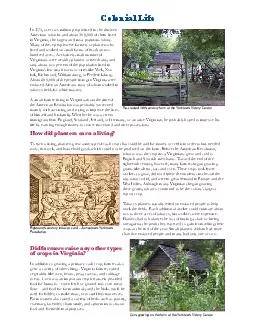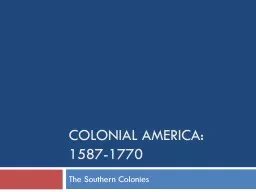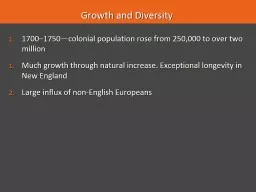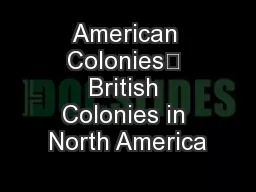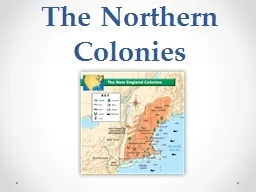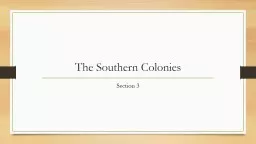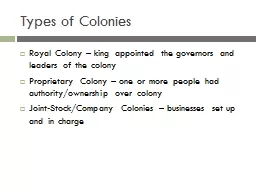PDF-Colonial Life In over two million people lived in the thirteen American colonies and
Author : luanne-stotts | Published Date : 2015-03-07
Many of these people were farmers or planters who lived and worked on small farms of less than two hundred acres A relatively small number of Virginians were wealthy
Presentation Embed Code
Download Presentation
Download Presentation The PPT/PDF document "Colonial Life In over two million peopl..." is the property of its rightful owner. Permission is granted to download and print the materials on this website for personal, non-commercial use only, and to display it on your personal computer provided you do not modify the materials and that you retain all copyright notices contained in the materials. By downloading content from our website, you accept the terms of this agreement.
Colonial Life In over two million people lived in the thirteen American colonies and: Transcript
Many of these people were farmers or planters who lived and worked on small farms of less than two hundred acres A relatively small number of Virginians were wealthy planters or merchants and only about two percent of the population lived in Virgini. COLONIAL SOCIETY. SPANISH. Christianity. Daily life. Pueblo Indians. Revolt. MAP 3.3 . European Colonies of the Atlantic Coast, 1607–39 . Virginia, on Chesapeake Bay, was the first English colony in North America, but by the mid-seventeenth century, Virginia was joined by settlements of Scandinavians on the Delaware River, and Dutch on the Hudson River, as well as English religious dissenters in New England. The territories indicated here reflect the vague boundaries of the early colonies.. Section 1: Early English Settlements. England in America. Queen Elizabeth gave . Sir Walter Raleigh . the . right to claim land in North America. Sent his expedition to look for a place to settle . and scouts chose Roanoke Island. The Unhealthy Chesapeake . Life in the American wilderness was harsh.. Diseases like malaria, dysentery, and typhoid killed many.. Few people lived to 40 or 50 years.. In the early days of colonies, women were so scarce that men fought. New England Colonies. 1. Massachusetts 1620. 2. Connecticut 1635. 3. Rhode Island 1636. 4. New Hampshire 1638 . Reasons settled. 1. Religious freedom. 2. Trade. Climate. Bitter cold winters. Short growing seasons. Europeans and American Indians maneuvered and fought for dominance, control, and security in North America, and distinctive colonial and native societies emerged.. Review of period 1 Group quizzes . Multiple choice questions. The Southern Colonies. Life in Virginia. Life different here than New England Colonies. Few towns b/c relied on rivers to ship goods. Tobacco. Foun. ded by Virginia Company of London. Founded for trade. Chap. 2, Section 2-3. I. New England Colonies. N.E. Colonies include:. . 1. Massachusetts. . 2. Connecticut. . 3. Rhode Island. . 4. New Hampshire. . 5. Maine (was part of Mass. Until 1820). Much growth through natural increase. Exceptional longevity in New England. Large influx of non-English Europeans. Scots-Irish Flee English Oppression. Largest non-English group. The Scots fled England for Ireland, then the Scots-Irish came to North America. Southern Colonies. Plantations. Tobacco and Rice. Slavery. Indentured Servitude. Aristocratic. Chesapeake: Virginia. Jamestown. Virginia Co.. Gold/Conversion/NW Passage. Virginia Charter. Tragedy. John Smith. . . . BY: J.A.SACCO. The Pilgrims of Plymouth. 101 aboard the Mayflower set sail in 1620 for America. Most were Separatists, looking for religious freedom. Led by Captain Miles Standish. Essential Questions:. What was the main goal of the Jamestown Colonists?. Why did they suffer so much in the first few years?. Who were the leaders of the colony and how successful were they?. What crop eventually saved the colony?. New Hampshire, Vermont, Maine, Massachusetts, Connecticut, and Rhode Island . Terrain. Hills and low mountains, narrow plains along coast. Thin and rocky soil (difficult for farming). Weather and Resources. Mason- . Dixon Line . Divided Southern Colonies from the rest of the . colonies. Between Pennsylvania and Maryland. 244 miles long. Named after Charles Mason and Jeremiah Dixon. They surveyed the land and created the “line.”. Types of Colonies Royal Colony – king appointed the governors and leaders of the colony Proprietary Colony – one or more people had authority/ownership over colony Joint-Stock/Company Colonies – businesses set up and in charge
Download Document
Here is the link to download the presentation.
"Colonial Life In over two million people lived in the thirteen American colonies and"The content belongs to its owner. You may download and print it for personal use, without modification, and keep all copyright notices. By downloading, you agree to these terms.
Related Documents

